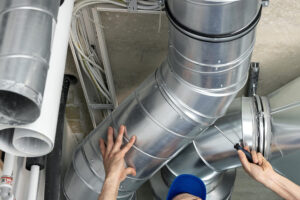 Your home’s air duct system plays a crucial yet often overlooked role in maintaining indoor comfort and air quality. As the hidden network that circulates conditioned air throughout your living spaces, ductwork can significantly impact your HVAC system’s efficiency, your energy bills, and even your family’s health. However, like any other component of your home, air ducts don’t last forever. Recognizing when it’s time for replacement is key to ensuring optimal performance and avoiding costly issues down the road.
Your home’s air duct system plays a crucial yet often overlooked role in maintaining indoor comfort and air quality. As the hidden network that circulates conditioned air throughout your living spaces, ductwork can significantly impact your HVAC system’s efficiency, your energy bills, and even your family’s health. However, like any other component of your home, air ducts don’t last forever. Recognizing when it’s time for replacement is key to ensuring optimal performance and avoiding costly issues down the road.
The Importance of Well-Maintained Ductwork
Before we dive into the signs of ductwork deterioration, it’s essential to understand why maintaining your air ducts is so crucial. A properly functioning duct system is the lifeline of your HVAC setup, responsible for distributing heated or cooled air evenly throughout your home. When ducts are in good condition, they contribute to:
- Improved energy efficiency
- Lower utility bills
- Enhanced indoor air quality
- Consistent temperature control
- Reduced strain on your HVAC equipment
Conversely, neglected or damaged ductwork can lead to a host of problems, including:
- Increased energy consumption
- Higher heating and cooling costs
- Poor indoor air quality
- Uneven temperature distribution
- Premature wear and tear on your HVAC system
With these factors in mind, let’s explore the five key indicators that suggest it’s time to consider replacing your air ducts.
Sign #1: Skyrocketing Energy Bills
One of the most noticeable signs that your ductwork may need replacement is a sudden and unexplained increase in your energy bills. While it’s normal for utility costs to fluctuate seasonally, a consistent upward trend could point to underlying issues with your air distribution system.
Understanding the Connection
When air ducts develop leaks, gaps, or other forms of damage, they allow conditioned air to escape before it reaches its intended destination. This means your HVAC system has to work harder and run longer to maintain the desired temperature, resulting in increased energy consumption.
Quantifying the Impact
Studies have shown that leaky or poorly insulated ductwork can lead to energy losses of up to 30% in some homes. This translates to hundreds of dollars wasted annually on unnecessarily high utility bills.
Conducting a Simple Test
To determine if your rising energy costs are due to ductwork issues, try this quick assessment:
-
- Set your thermostat to a specific temperature
- Check the temperature in different rooms using a reliable thermometer
- Compare the readings to identify any significant discrepancies
If you notice substantial temperature variations between rooms, it could indicate that your ductwork is not distributing air efficiently.
When to Consider Replacement
While minor leaks can often be sealed, extensive damage or deterioration may warrant a complete ductwork replacement. If your energy bills have been steadily climbing despite your efforts to conserve energy, it’s time to have a professional HVAC technician inspect your air ducts.
Sign #2: Poor Indoor Air Quality
The quality of air inside your home directly impacts your family’s health and comfort. If you’ve noticed a decline in indoor air quality despite regular cleaning and maintenance, your air ducts could be the culprit.
Common Air Quality Issues
Deteriorating ductwork can contribute to various air quality problems, including:
-
- Excessive dust accumulation
- Increased allergen presence
- Unpleasant odors
- Mold and mildew growth
- Higher levels of airborne pollutants
Health Implications
Poor indoor air quality can lead to a range of health issues, particularly for individuals with respiratory conditions, allergies, or compromised immune systems. Some common symptoms associated with poor air quality include:
-
- Frequent sneezing or coughing
- Itchy or watery eyes
- Headaches
- Fatigue
- Skin irritation
- Exacerbation of asthma or allergy symptoms
Identifying Ductwork-Related Air Quality Issues
To determine if your air quality problems stem from faulty ductwork, look for these signs:
-
- Visible dust or debris around air vents
- Musty odors when the HVAC system is running
- Increased allergy symptoms when indoors
- Excessive humidity or condensation
The Role of Duct Cleaning
While professional duct cleaning can help improve air quality in some cases, it’s not always a long-term solution. If your ducts are severely damaged or contaminated, cleaning may not be sufficient to address the underlying issues.
When Replacement is Necessary
If you’ve had your ducts professionally cleaned and still experience persistent air quality issues, it may be time to consider replacement. A new, properly sealed duct system can significantly improve indoor air quality and create a healthier living environment for your family.
Sign #3: Inconsistent Temperatures Throughout Your Home
One of the primary functions of your ductwork is to distribute conditioned air evenly throughout your home. If you’ve noticed significant temperature variations between rooms or floors, it could be a sign that your air ducts are no longer performing effectively.
Common Temperature Inconsistencies
Some typical scenarios that indicate ductwork problems include:
- Certain rooms feeling much warmer or cooler than others
- Upstairs areas being consistently hotter than lower levels
- Temperature fluctuations within the same room
- Difficulty maintaining a comfortable temperature in specific areas
Causes of Uneven Heating and Cooling
While there can be multiple reasons for temperature inconsistencies, ductwork issues are often to blame. Some potential causes include:
- Leaks or gaps in the ductwork
- Poorly designed or improperly sized ducts
- Inadequate insulation
- Blockages or obstructions within the system
Assessing Your Home’s Temperature Distribution
To evaluate the extent of your temperature inconsistencies, try this simple method:
- Set your thermostat to a specific temperature
- Wait for your HVAC system to run for at least 15-20 minutes
- Use a reliable thermometer to measure the temperature in different rooms
- Note any variations greater than 3-4 degrees Fahrenheit
The Impact on Comfort and Efficiency
Inconsistent temperatures not only affect your comfort but also force your HVAC system to work harder, leading to increased energy consumption and potential wear and tear on the equipment.
When to Consider Duct Replacement
If you’ve tried addressing temperature inconsistencies through other means (such as adjusting vents or adding insulation) without success, it may be time to evaluate your ductwork. A professional HVAC technician can assess your system and determine whether replacement is necessary to achieve more uniform temperature distribution throughout your home.
Sign #4: Visible Damage or Deterioration
While much of your ductwork may be hidden from view, there are often visible sections in areas like attics, basements, or crawl spaces. Regularly inspecting these accessible portions can help you identify signs of damage or deterioration that may indicate the need for replacement.
Types of Visible Damage
When examining your ductwork, look for the following issues:
-
- Dents or crushed sections
- Holes or tears in the duct material
- Disconnected or loose joints
- Visible mold or mildew growth
- Rust or corrosion (on metal ducts)
- Sagging or collapsed sections
The Dangers of Damaged Ductwork
Visible damage to your air ducts can lead to a variety of problems, including:
-
- Air leakage and energy loss
- Reduced HVAC system efficiency
- Poor indoor air quality
- Increased risk of pest infestations
- Potential for moisture-related issues
Assessing the Extent of Damage
While minor issues like small holes or loose connections can often be repaired, extensive damage or widespread deterioration may necessitate a full duct replacement. Consider these factors when evaluating the condition of your ductwork:
-
- Age of the system
- Extent and severity of visible damage
- Presence of multiple issues throughout the ductwork
- History of previous repairs
DIY Inspection Tips
To conduct a basic inspection of your visible ductwork:
-
- Use a flashlight to examine all accessible sections
- Gently press on the ducts to check for weak spots or areas of give
- Look for any signs of moisture or water damage
- Check for loose connections or gaps between duct sections
- Note any unusual odors or signs of mold growth
When to Call a Professional
If you notice any significant damage or are unsure about the condition of your ductwork, it’s best to consult a qualified HVAC technician. They can perform a thorough inspection and provide expert recommendations on whether repair or replacement is the most appropriate course of action.
Sign #5: Age and Outdated Materials
Like any other component of your home, air ducts have a finite lifespan. As ductwork ages, it becomes more susceptible to damage, inefficiency, and other issues that can impact your HVAC system’s performance. Additionally, older duct systems may be constructed from materials that are no longer considered optimal for air distribution.
Typical Lifespan of Air Ducts
While the longevity of ductwork can vary depending on factors such as material quality, installation, and maintenance, here are some general guidelines:
-
- Flexible ducts: 10-15 years
- Sheet metal ducts: 20-30 years
- Fiberglass-lined ducts: 10-20 years
Factors That Affect Duct Longevity
Several factors can influence how long your air ducts will last, including:
-
- Quality of initial installation
- Frequency of maintenance and cleaning
- Local climate and environmental conditions
- Presence of pests or rodents
- Changes to your home’s layout or HVAC system
Outdated Duct Materials
Some older homes may have ductwork constructed from materials that are no longer considered ideal for air distribution. These can include:
-
- Asbestos-containing materials (in homes built before the 1980s)
- Fiberglass ductboard (prone to deterioration and potential fiber shedding)
- Flexible plastic ducts (easily damaged and prone to sagging)
Benefits of Modern Duct Systems
Replacing old or outdated ductwork with a modern system can offer several advantages:
-
- Improved energy efficiency
- Better air quality and filtration capabilities
- Enhanced durability and longevity
- Reduced noise levels
- Compatibility with smart home technologies
When to Consider Age-Related Replacement
If your ductwork is approaching or has exceeded its expected lifespan, it’s worth having a professional assessment to determine if replacement is necessary. This is particularly important if you’ve noticed any of the other signs mentioned in this article or if you’re planning other HVAC upgrades.
The Duct Replacement Process
If you’ve identified one or more of the signs discussed above, you may be wondering what the duct replacement process entails. While every home is unique, here’s a general overview of what you can expect when replacing your air ducts:
Initial Assessment
A qualified HVAC technician will conduct a thorough inspection of your existing ductwork and HVAC system. This assessment may include:
-
- Visual inspection of accessible duct sections
- Airflow and pressure testing
- Evaluation of your home’s layout and HVAC needs
- Discussion of any comfort or air quality concerns
System Design
Based on the assessment, the technician will design a new duct system tailored to your home’s specific requirements. This may involve:
-
- Calculating proper duct sizes and airflow requirements
- Determining optimal duct routes and placement
- Selecting appropriate materials for your needs and budget
- Addressing any existing issues or inefficiencies
Removal of Old Ductwork
The next step involves carefully removing the existing ductwork. This process may require:
-
- Accessing attic, basement, or crawl space areas
- Disconnecting ducts from vents and HVAC equipment
- Proper disposal of old materials, especially if asbestos is present
Installation of New Ducts
With the old system removed, the technicians will proceed with installing the new ductwork. This typically includes:
-
- Hanging and securing new duct sections
- Properly sealing all joints and connections
- Installing insulation around the ducts (if necessary)
- Connecting the new system to existing vents and HVAC equipment
Testing and Balancing
Once the new ductwork is in place, the technicians will conduct thorough testing to ensure proper function and efficiency. This may involve:
-
- Checking for air leaks
- Measuring airflow at each vent
- Adjusting dampers to balance air distribution
- Verifying proper system operation
Final Inspection and Cleanup
The process concludes with a final inspection and cleanup, including:
-
- Ensuring all work areas are clean and free of debris
- Reviewing system operation with the homeowner
- Providing any necessary maintenance instructions
- Addressing any questions or concerns
Choosing the Right HVAC Professional
Selecting a qualified HVAC professional is crucial for ensuring a successful duct replacement project. Here are some tips for finding the right contractor:
- Look for licensed and insured professionals
- Check for certifications from reputable industry organizations
- Read customer reviews and ask for references
- Get multiple quotes and compare them carefully
- Ask about warranties and guarantees on both labor and materials
- Ensure the contractor pulls all necessary permits for the work
We Provide Air Duct Replacement Services
When you’re considering air duct installation services, you’re making a wise investment in your home’s comfort and efficiency. By having new air ducts professionally installed, you ensure that your HVAC system operates at peak performance, distributing conditioned air evenly throughout your living spaces.
> Learn More
Recognizing the signs that it’s time to replace your air ducts is essential for maintaining a comfortable, efficient, and healthy home environment. By paying attention to indicators such as rising energy bills, poor indoor air quality, inconsistent temperatures, visible damage, and the age of your system, you can make informed decisions about when to invest in duct replacement.
Contact Us (954-909-4281) For a Free Estimate
Book an Appointment
 About South Florida Ducts
About South Florida Ducts
Air Duct Cleaning
We remove the maximum amount of the dirt and dust possible.
> Learn More
Air Duct Restoration
Hospital grade duct restoration when ducts need more than a vacuuming.
> Learn More
New Air Ducts Installed
New air ducts vastly improve your AC’s efficiency and overall air quality.
> Learn More
A/C Services
From routine maintenance visits to custom installations, SFD does it all and does it well.
> Learn More

 About South Florida Ducts
About South Florida Ducts